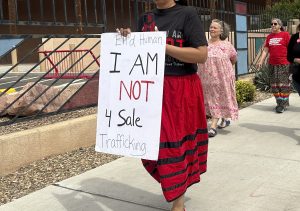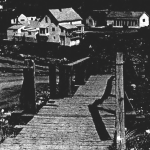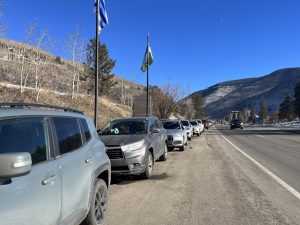Horn Ranch has history of colorful characters

Special to the Enterprise |
The expansive and historic Horn Ranch property — lush meadows bordered by red cliff “gates” on both sides and bisected by the Eagle River — defines the character of the valley between Wolcott and Eagle.
But the landscape isn’t the only thing colorful about the property. For more than a century, colorful characters worked that land and left their legacies.
The Horn Ranch was originally prospected by rancher Rupert “Rupe” Sherwood. Sherwood was described as an “early settler of Eagle County, pioneer prospector and trapper” in his Sept. 4, 1931 obituary in the Eagle Valley Enterprise. He came to Colorado in 1862, driving a herd of 300 horses from the Mid West to the Pacific coast. “The lure of Colorado was too strong to permit the youth to go on to the Pacific, and he gave up the job as a herder of horses and took up trapping of game and fur-bearing animals, then plentiful in the county tributary to the Continental Divide,” reported the Enterprise.
Sherwood also tried his hand at prospecting and he told the story of how he came upon a cache of pure gold in the Montezuma district in Summit County. Sherwood said both he and another prospector found the same claim. “It was his location, but he had gone to Georgetown to get grub. I intended to give him his rights, but he pulled out a roll and handed me $500 and asked if that would settle the agreement. Of course it worked and he later made a famous mine.”
Sherwood gave up the trapping and prospecting life in 1883 to homestead a parcel eight miles east of the fledgling town of Eagle. But eventually, he again succumbed to the call of the prospecting life and sold the property to Mr. and Mrs. George W. Watson.

Support Local Journalism
Sherwood returned to South Park where he and his faithful burro, Punes, became prominent citizens of Fairplay. When Punes died, Sherwood erected a monument in his honor along the main street of the community. When he died, Sherwood’s final request was that his body be cremated and his ashes be scattered at the burro’s grave.
Back in Eagle County, the next owners of what had been the Sherwood property developed “one of the best improved cattle ranches in the county,” according to the Enterprise. During the Watsons’ ownership, one of the ranch’s biggest claims to fame unfolded.
Brown Palace Quarry
According to Kathy Heicher of the Eagle County Historical Society, the archives at the Colorado Historical Museum include a transcript titled “Memories of Eagle County in the 1880s” authored by Amy M. Bowen, which details how stone quarried from the ranch site was used to build the famed Brown Palace Hotel in Denver.
“Bowen was the daughter of Avon area homesteader John Conard Metcalf, and she mentions the remnants of a quarry in the red canyon west of Wolcott,” said Heicher. “Bowen describes the area as “Sherwood,” and describes the machinery pieces, and half-chiseled blocks of red sandstone at the site of the abandoned quarry. According to her account, the sandstone quarry started out as a rather ambitious operation that was brought to a sudden halt by the outbreak of smallpox among the workers. Bowen reported that many of the quarry workers died; others fled. Afterwards, nobody could be persuaded to go near the place, and the whole quarry venture was given up.”
Heicher said historians for the Brown Palace hotel confirm that the distinctive red sandstone blocks of the building came from Wolcott. The grand hotel was built in 1892, at a cost of $1.5 million.
Rusted and deteriorating mechanical equipment can still be spotted north of Interstate 70 along the cliff that was part of the quarry operation.
Ranch’s namesake owner
Rancher Leonard Horn purchased the property in 1938, and as his signature brand declared, he was the VII cowboy. He is remembered as a real life Marlboro Man.
“As a little girl, Leonard was like a John Wayne hero to me,” wrote Rita Dittrich, who lived on the Horn Ranch as a child, in a obituary published in the September 1985 edition of Cattle Guard.
“He always wore his dark glasses, neck-kerchief, hat and spurs,” wrote Dittrich. “Riding along the VII Ranch near Wolcott was probably the most joyous times for him.”
Dittrich recalled how Horn was a horseback daredevil. She described how he would ride up the quarry draw to the top of the sheer cliff, which features a 300-foot drop, and then jump a crevice, “sometimes without a bridle,” to pose for pictures at the balanced rock point.
“I asked him what would happen if Sundeck (his horse) should slip or forget to hop. He nonchalantly smiled and replied ‘You would really get an action shot.’”
Horn was a widely respected cattleman and an avid cutting horse showman. He served as a member of the Colorado Cattlemen’s Association Board of Directors and as president of the Eagle County Stockgrowers Association. In 1965, Colorado State University named him Livestock Man of the Year and in 1982 he received the first Colorado Cattlemen’s Gold Award for distinguished service. He was a staunch member of the Republican Party and an active member of the Eagle community.
He passed away in 1985 at the age of 76 from internal injuries sustained after being thrown from a horse.
The Cross on the Hill
During Horn’s ownership of the property, a wooden cross was placed on the red cliff over looking the valley. Dittrich said her father placed the cross there in 1962 for Easter sunrise services.
“The cross, although it was never cemented into the ground, stayed in place despite brutal winters until 1976, when vandals tore it down and tossed it over the cliff,” said Heicher. “Horn, at the time, blamed the vandalism on ‘hippies with long hair who came in a Volkswagon.’”
Heicher said that on Good Friday in 1979, The Rev. Bruce Dunsdon and members of the Eagle Baptist Church nailed the original cross back together and re-installed it at the cliff. Wooden benches were also installed at the site and a wood pulpit was cut out of a old cedar tree.
“Many local residents have attended services there, and can attest to the beauty of a sunrise view from that location,” said Heicher.
Ranch sold
In 1993, Swedish shipping magnate Magnus Lindholm, through an entity called Piney Valley Land Trust, purchased the Horn Ranch property, encompassing 1,104 acres, for $1.34 million.
At that time, his Piney Valley Land Trust held more than 23,000 acres in Eagle County making the entity the largest landholder in the county.










